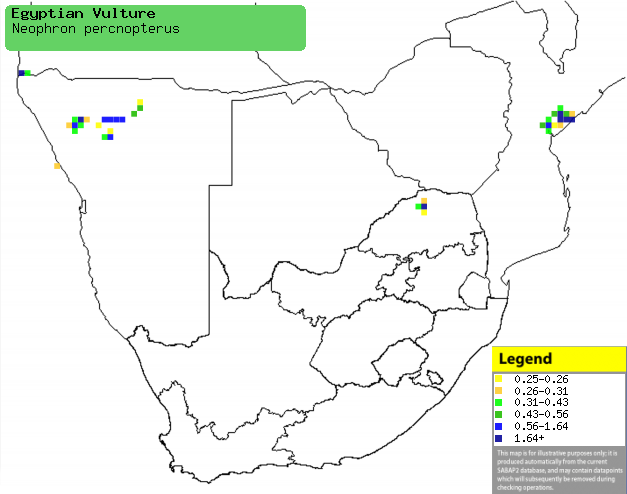|
Neophron percnopterus (Egyptian
vulture)
Egiptiese aasvoël [Afrikaans]; Inkqo [Xhosa]; uPhalane
[Zulu]; Lehonyane, Tlakatsooana [South Sotho]; Mpenyani [Tsonga]; aasgier,
Egyptische gier, witte krenggier [Dutch]; Vautour percnoptère [French];
Schmutzgeier [German]; Abutre do Egipto [Portuguese]
Life
> Eukaryotes >
Opisthokonta
> Metazoa (animals) >
Bilateria >
Deuterostomia > Chordata >
Craniata > Vertebrata (vertebrates) > Gnathostomata (jawed
vertebrates) > Teleostomi (teleost fish) > Osteichthyes (bony fish) > Class:
Sarcopterygii (lobe-finned
fish) > Stegocephalia (terrestrial
vertebrates) > Tetrapoda
(four-legged vertebrates) > Reptiliomorpha > Amniota >
Reptilia (reptiles) >
Romeriida > Diapsida > Archosauromorpha > Archosauria >
Dinosauria
(dinosaurs) > Saurischia > Theropoda (bipedal predatory dinosaurs) >
Coelurosauria > Maniraptora > Aves
(birds) > Order: Falconiformes
> Family: Accipitridae
Distribution and habitat
Occurs in southern Europe, North Africa and Sub-Saharan
Africa. In southern Africa it was previously uncommon, but since the 1940s it
has become more and more rare; today it is nearly extinct in the region,
with isolated populations in north-west Namibia, northern Limpopo Province and
central Mozambique. It has also been recorded as a vagrant to Zimbabwe, the
Northern and Eastern Cape and KwaZulu-Natal. It generally prefers arid open
habitats, such as plains and semi-desert, occasionally moving to the seashore.
|
 |
|
Distribution of Egyptian vulture in southern Africa,
based on statistical smoothing of the records from first SA Bird Atlas
Project (©
Animal Demography unit, University of
Cape Town; smoothing by Birgit Erni and Francesca Little). Colours range
from dark blue (most common) through to yellow (least common). |
Movements and migrations
Not well understood, but it may still be a
breeding resident in Namibia, Mozambique and Limpopo Province.
Food
Most of its foraging time is spent scavenging, soaring high
up in the air, then descending to the feed on a carcass. Due
to its small size relative to other scavengers, it is low on the pecking order,
so it collects scraps of food along the outskirts of the area around the carcass. It also
eats a variety of bird eggs, especially of ostriches, flying next the egg and
hurling a stone at it until it breaks. The following food items have been recorded
in its diet:
Breeding
- There are very few southern African breeding records, hence there is scant
information on its breeding habits.
- Monogamous solitary nester, building a large platform of sticks lined
with soft material, such as sheepskin. In one instance it was placed in a
natural cavity on a cliff ledge.
- Egg-laying season is from August-November, possibly December.
- It lays 1-2 eggs, which in Europe are incubated for about 42 days.
- The chicks stay in the nest for approximately 77 days (also recorded in
Europe).
Threats
Not internationally threatened, but nearly extinct in
southern Africa, as it is not certain that it even breeds in the region
anymore; the last breeding record was in 1923. This is thought to have been
caused by a great reduction in the number of indigenous antelope herds, improved
hygiene around human settlements and competition from introduced scavengers such
as pigs. It has also been impacted by persecution by ostrich farmers, and
incidental poisoning.
References
-
Hockey PAR, Dean WRJ and Ryan PG 2005. Roberts
- Birds of southern Africa, VIIth ed. The Trustees of the John Voelcker
Bird Book Fund, Cape Town.
|
